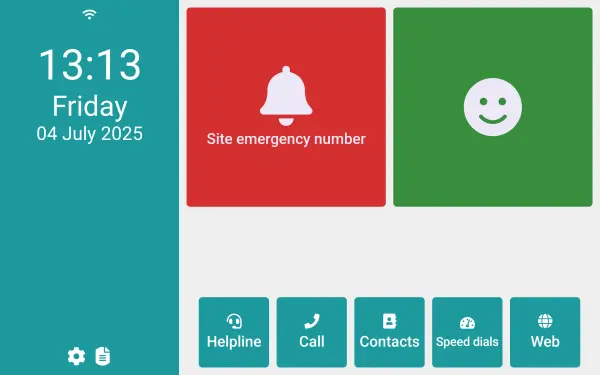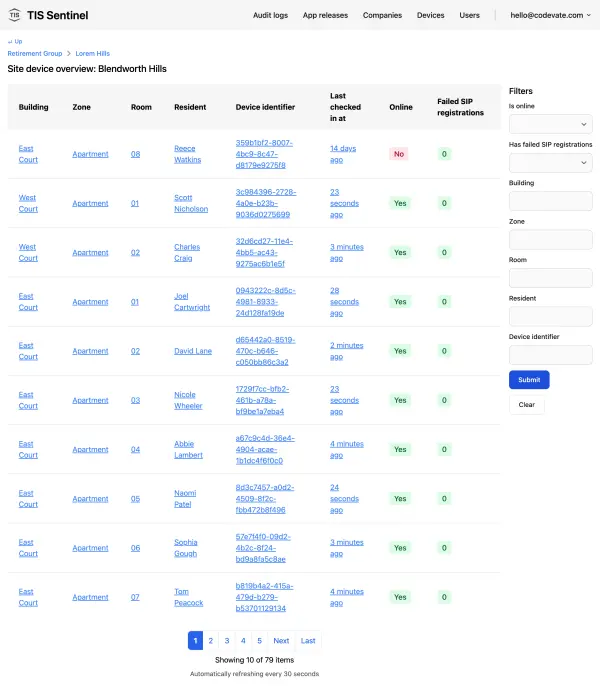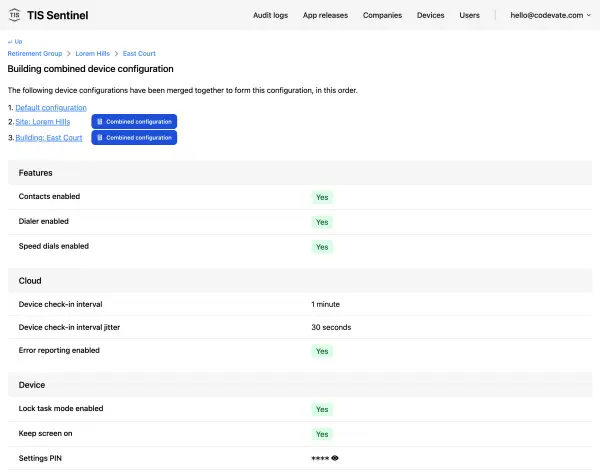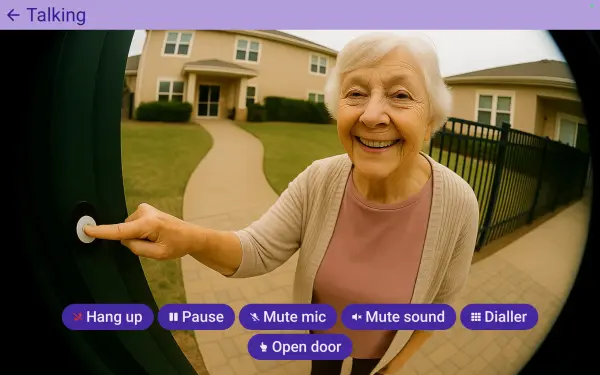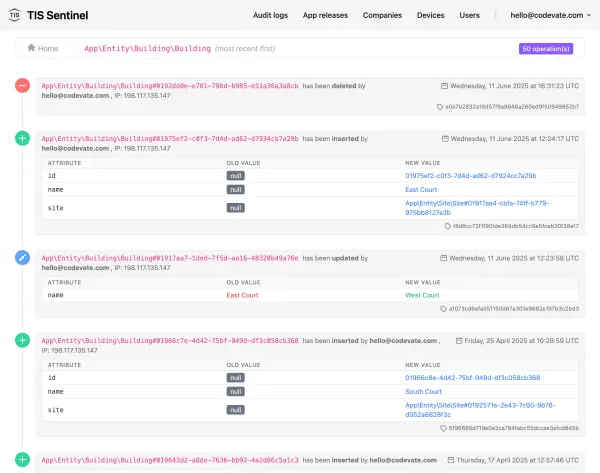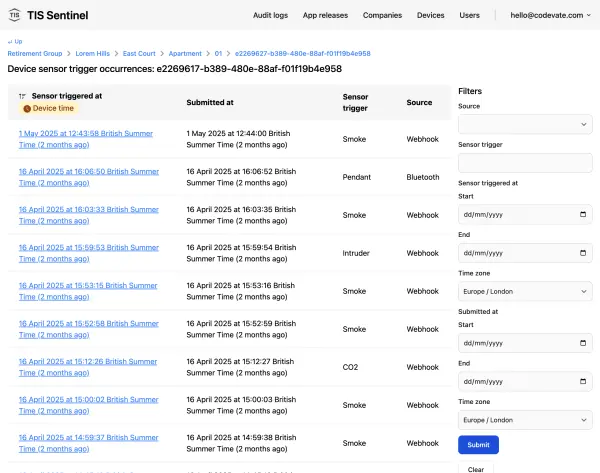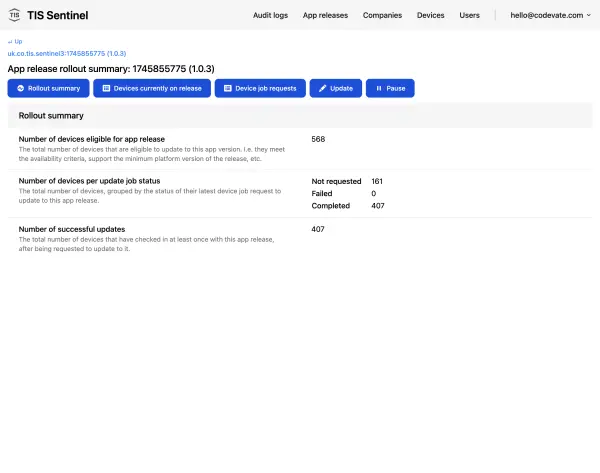TIS Sentinel SmartLINK V3
Integrated retirement community cloud portal and tablet app
A centralised web platform with supporting tablet app for improving operational efficiency and care coordination.
"Codevate have worked with us to plan, develop, and implement our bespoke software platform. They have consistently proven to be an excellent app development partner, demonstrating a clear understanding of TIS’s requirements and those of our customers — both in the immediate term and for our longer-term objectives. We highly recommend their detailed software specification writing service – it left no stone unturned and was the key to our project running so smoothly."
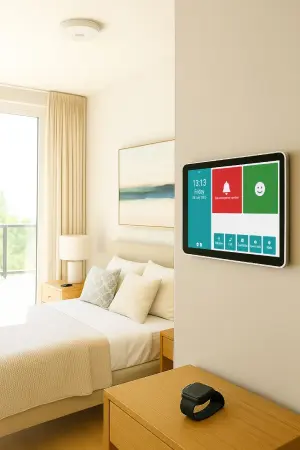
Rebuild & replace of a legacy software system
TIS Sentinel SmartLINK V3 is a bespoke Android tablet app and supporting web portal. The tablet is wall-mounted within integrated retirement communities (IRCs). Residents are able to make calls, respond to wellbeing checks, and call for help. The cloud portal allows bulk remote management of the devices, which is a huge time saver, as well as monitoring of resident wellbeing.
Our client previously white-labelled an off-the-shelf solution and was suffering from vendor lock-in, facing multiple technical and operational challenges. We identified multiple pain points and wrote a detailed specification for a bespoke system that would give our client the control it needed over their software.
After a successful launch of the new tablet app, our client now manages a large fleet of devices over multiple sites remotely. The time taken to set up and manage devices has been dramatically reduced, increasing operational efficiency.
Want to build your own mobile app or web portal?
Services delivered
- App development
- Web development
- Technical evaluations of pre-existing software
- Consultancy
- DevOps and infrastructure
Technologies used
- Native Android (Kotlin)
- PHP - Symfony
- PostgreSQL database
- AWS cloud infrastructure
Highlights of TIS Sentinel SmartLINK V3
Kiosk/COSU (Corporate Owned Single Use) Android app for residents
- Integrated app that provides a seamless bespoke user interface
- Secure, tamper-proof solution preventing access to the underlying Android OS
- Powered by Android to provide advanced features, without building from scratch
- Cost saving on bespoke hardware, as the app could support many off-the-shelf Android tablets - solving previous vendor lock-in issues
- Allows users to respond to regular daily wellbeing checks
- Features include wellbeing, monitoring, concierge, door entry, calls, alarms, etc.
Remote device and non-invasive resident monitoring
- Allows monitoring the health of a large fleet of devices
- Device check-ins at regular intervals provide deep insights into device health
- Resident wellbeing monitoring at a glance to support care providers
- Overviews provided at the company, site, building, zone, and even room level granularity
Mobile device management (MDM)
- Bespoke MDM solution allows remote configuration and management of a large fleet of devices
- Cascading device configuration profiles enable configuring many devices at once, without repetition tamper-proof solution preventing access to the underlying Android OS
- Configuration can be set at the company, site, building, zone, room or individual device level
- Huge time-saving and human error reduction benefits over manually configuring each device on an individual basis
- Large cost-saving potential over existing MDMs, which typically charge per device per month
Sensor/alarm reporting
- Extremely flexible sensor integration, allowing many types of sensors to trigger an alarm
- Bluetooth integration with personal alarm pendants, automatically calling an emergency number when pressed
- Sensors include: smoke alarms, carbon monoxide alarms, intruder alarms, etc.
- Remote sensor monitoring at a glance in the cloud portal
App update rollout system
- Bespoke system to roll out app updates to fleets of devices, giving full control and minimal service interruption
- Integrated with the cloud portal, allowing rolling out new versions to individual client sites so that engineers can be present to handle any issues
- Staged rollouts, allowing updates to initially be rolled out to a small number of devices and continued if successful - reducing the risk of issues becoming widespread
- Update time windows can be specified, so that users aren't interrupted during typical usage hours
Behind-the-scenes and other top features
Not all heroes wear capes. These behind-the-scenes features don't have screenshots, but form an important part of the project.
User permissions and access control support
Granular user roles ensure only the right users have access to sensitive features and data, improving security.
Point-in-time database back-ups for disaster recovery
Automatic backups allow quick recovery in case of data loss, helping to maintain business continuity.
Highly available AWS infrastructure
Scalable cloud infrastructure on AWS providing a low maintenance system with a high service uptime.
QR code-based device onboarding process
Engineers can onboard devices quickly and accurately by scanning a QR code, reducing human error and speeding up provisioning.
Want to develop an app or cloud portal like this?
"Codevate have worked with us to plan, develop, and implement our bespoke software platform. They have consistently proven to be an excellent app development partner, demonstrating a clear understanding of TIS’s requirements and those of our customers — both in the immediate term and for our longer-term objectives. We highly recommend their detailed software specification writing service – it left no stone unturned and was the key to our project running so smoothly."
- 100% UK-based
- Complimentary scoping call
- At-a-glance feasibility analysis
- No obligation high-level proposal
- Work with an expert to evolve your idea
Project outline: building the bespoke software
Our client previously white-labelled an integrated retirement community (IRC) system, using supplier-provided tablets mounted on residents' walls to provide features such as wellbeing monitoring, calling, alarms, etc. After two iterations of the system, which had faced numerous issues, our client approached us to build a bespoke system to give them full control.
The project started out with a period of consultancy where we produced a detailed software specification, as our client's requirements were high in complexity.
We identified the core project goals:
-
Strengthen our client's competitive advantage
- Our client faced the risks associated with vendor lock-in, where they did not have a choice of hardware or control over the software.
- Building a bespoke system would build value in the company, as well as reduce risks.
-
Capitalise on opportunities for operational efficiencies
- We identified that a significant amount of time was being spent on device setup and management. To improve this, we proposed a system to streamline this process with remote management.
- Previously, devices could not be set up until a site had power and internet. With our solution, devices could be configured prior to this, improving lead times.
-
Allow our client to gain control over software development
- By being in control of their own software, our client would no longer be constrained by their previous supplier.
- This would allow our client to rapidly innovate by responding to customer and market needs.
-
Improve code quality, cybersecurity and cloud infrastructure
- There were often issues with the previous supplier, such as new updates containing bugs and breaking unrelated functionality.
- Our high quality engineering and QA process would help to reduce client-facing issues, where our client was taking reputation hits.
Our solution
As set out in our software specification, we developed an Android tablet app for residents, and a supporting cloud portal backed by an AWS infrastructure.
Our proposed cascading device configuration system now allows devices to be configured at the company, site, build, zone, room, or even device level. This solution greatly reduced the amount of time that engineers need to spend setting up and managing devices. It also helps to reduce the amount of human error that occurred from manually duplicating configurations across multiple devices.
Our QR code-based device onboarding now allows devices to be configured before a site has power and/or internet. This can significantly reduce lead time, as devices can be ready to go within minutes of a site coming online.
Delivering the new software
The new TIS Sentinel SmartLINK V3 system has successfully been rolled out to multiple live client sites, with the app being deployed across a large number of devices.
Our client now has full control over the direction of the software and has already made several updates in order to meet the needs of prospective clients - work they could not have won before our bespoke solution. Through improved operational efficiencies, they are now able to set up and manage sites in a fraction of the time.
Want to build your own mobile app or web portal?
Looking to develop software that's greater than the sum of its parts?
Send us a message